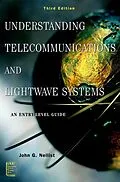The up-to-date edition of the bestselling guide to the basics of
telecommunications and digital technology
Understanding Telecommunications and Lightwave Systems
presents a nontechnical treatment of how voice, video, and
multimedia can simultaneously travel over today's evolving
telecommunications systems. This updated Third Edition provides a
comprehensive overview of the telecommunications field as well as a
detailed introduction to the latest lightwave technology.
The author's examination of recent techniques and developing
technologies in telecommunications includes:
* Third-generation cell phones with microbrowser
capabilities
* Changes in the global PCS network
* Optical switching and transmission parameters
* Lightwave systems and Dense Wavelength Division
Multiplexing
* A new chapter (Chapter 17: The Internet) that examines this
multimedia structure and the network economy it has created
* Satellite communications, new transcontinental carriers,
lightwave undersea systems, and other advances toward improving
global communication
Understanding Telecommunications and Lightwave Systems is
the perfect introduction for anyone whose work requires a
fundamental understanding of current developments in
telecommunications, as well as for students or inquiring readers
who want an overview of telecommunications and the exciting
technology of lightwave communications.
Autorentext
JOHN G. NELLIST led the development and implementation of fiber
optic technology into the British Columbia telephone network as
General Transmission Engineering Manager at Telus (formerly BC
Telecom). He was appointed overall coordinator for the first field
trial of a fiber optic transmission system in 1978 and presented
one of the first papers on an operating fiber optic system in 1979
at the International Fiber Optic Conference.
With more than forty years of telecommunications experience, John
Nellist has published and presented numerous technical papers and
articles on the subject. Currently a consultant at Sarita
Enterprises, Ltd., Nellist has also coauthored two books with
Elliott M. Gilbert, Telecommunications Wiring for Commercial
Buildings and Understanding Modern Telecommunications and the
Information Superhighway.
Zusammenfassung
The up-to-date edition of the bestselling guide to the basics of telecommunications and digital technology
Understanding Telecommunications and Lightwave Systems presents a nontechnical treatment of how voice, video, and multimedia can simultaneously travel over today's evolving telecommunications systems. This updated Third Edition provides a comprehensive overview of the telecommunications field as well as a detailed introduction to the latest lightwave technology.
The author's examination of recent techniques and developing technologies in telecommunications includes:
- Third-generation cell phones with microbrowser capabilities
- Changes in the global PCS network
- Optical switching and transmission parameters
- Lightwave systems and Dense Wavelength Division Multiplexing
- A new chapter (Chapter 17: The Internet) that examines this multimedia structure and the network economy it has created
- Satellite communications, new transcontinental carriers, lightwave undersea systems, and other advances toward improving global communication
Understanding Telecommunications and Lightwave Systems is the perfect introduction for anyone whose work requires a fundamental understanding of current developments in telecommunications, as well as for students or inquiring readers who want an overview of telecommunications and the exciting technology of lightwave communications.
Inhalt
Introduction 1
1 The Evolution of Telecommunications 3
The Telegraph 3
The Telephone 3
Wireless Communications 4
AT&T Monopoly 4
Trans-Canada System 4
Semiconductors 5
Digital Communications 5
Satellite Communications 6
Fiber Optics 6
AT&T Break-Up 6
Telecommunications Act of 1996 8
The Meltdown 10
Conclusion 10
2 Analog Transmission 12
Conclusion 15
Review Questions for Chapter 2 15
3 Digital Transmission 17
Conclusion 19
Review Questions for Chapter 3 20
4 Basic Multiplexing Techniques 21
Brief History 21
FDM 21
TDM 22
Pulse-Code Modulation 22
Conclusion 27
Review Questions for Chapter 4 27
5 Switching Hierarchy 28
Brief History '. 28
Divestiture 30
Conclusion 32
Review Questions for Chapter 5 32
6 North American Digital Hierarchies 34
Conclusion 37
Review Questions for Chapter 6 37
7 Transmission 38
Transmission Level 39
Via Net Loss (VNL) 40
All-Digital Network 40
Echo Suppressors and Echo Cancellers 43
Split Echo Suppressor 44
Full Echo Suppressor 45
Digital Echo Canceller 45
Conclusion 46
Review Questions for Chapter 7 47
8 The Local Subscriber Loop 48
Brief History 48
The Local Loop 48
Digital Subscriber Carrier Systems 50
Asymmetric Digital Subscriber Lines 52
Conclusion 54
Review Questions for Chapter 8 55
9 Microwave Radio 56
Brief History 56
Digital Radio 56
Design Considerations 58
SONET Radio 60
Conclusion 61
Review Questions for Chapter 9 61
10 Satellite Communications 63
Brief History 63
Geostationary (GEO) Satellites 65
Parking Slots 66
Transponders 67
The Footprint 68
Time Delay 68
Global Positioning System 70
MEO and LEO Satellites 71
Direct-to-Home Satellite System 75
Satellite Operators 75
Conclusion 76
Review Questions for Chapter 10 76
11 Switching Systems 78
The Strowger Switch 78
Panel Switching Syste 79
Crossbar Switch 79
The First Electronic Switch 80
The Digital Switch 81
The Optical Switch 84
Optical Switches with Electrical Cores 85
All-Optical Switches 85
Conclusion 90
Review Questions for Chapter 11 90
12 Private Branch Exchange 92
Brief History 92
Analog PBX 92
Digital PBX 93
Conclusion 95
Review Questions for Chapter 12 96
13 Traffic Considerations 97
Brief History 97
CCS 97
Grade of Service 98
Internet Congestion 99
Conclusion 101
Review Questions for Chapter 13 101
14 Video Transmission 102
Brief History 102
Video Compression 102
Switched Data Services 103
Video Codecs 103
Videophone 104
Multimedia 105
Conclusion 107
Review Questions for Chapter 14 108
15 Wireless 109
Brief History 109
Cellular Telephone Service 109
The Mobile Unit 111
Personal Communications Services (PCS) 113
The Standards 114
...